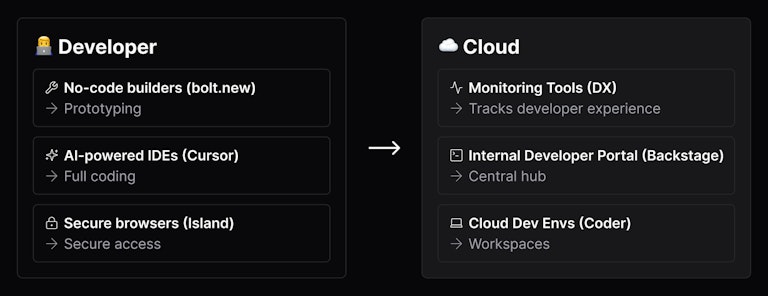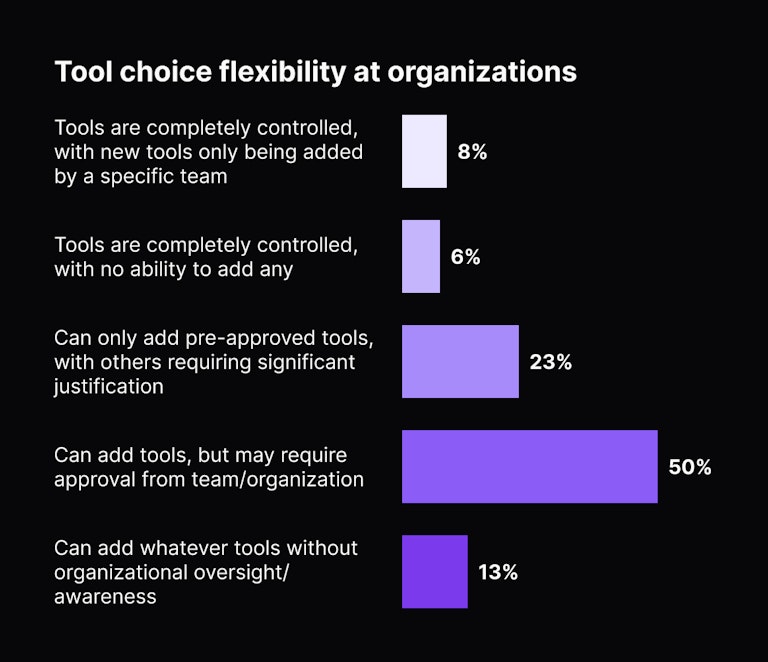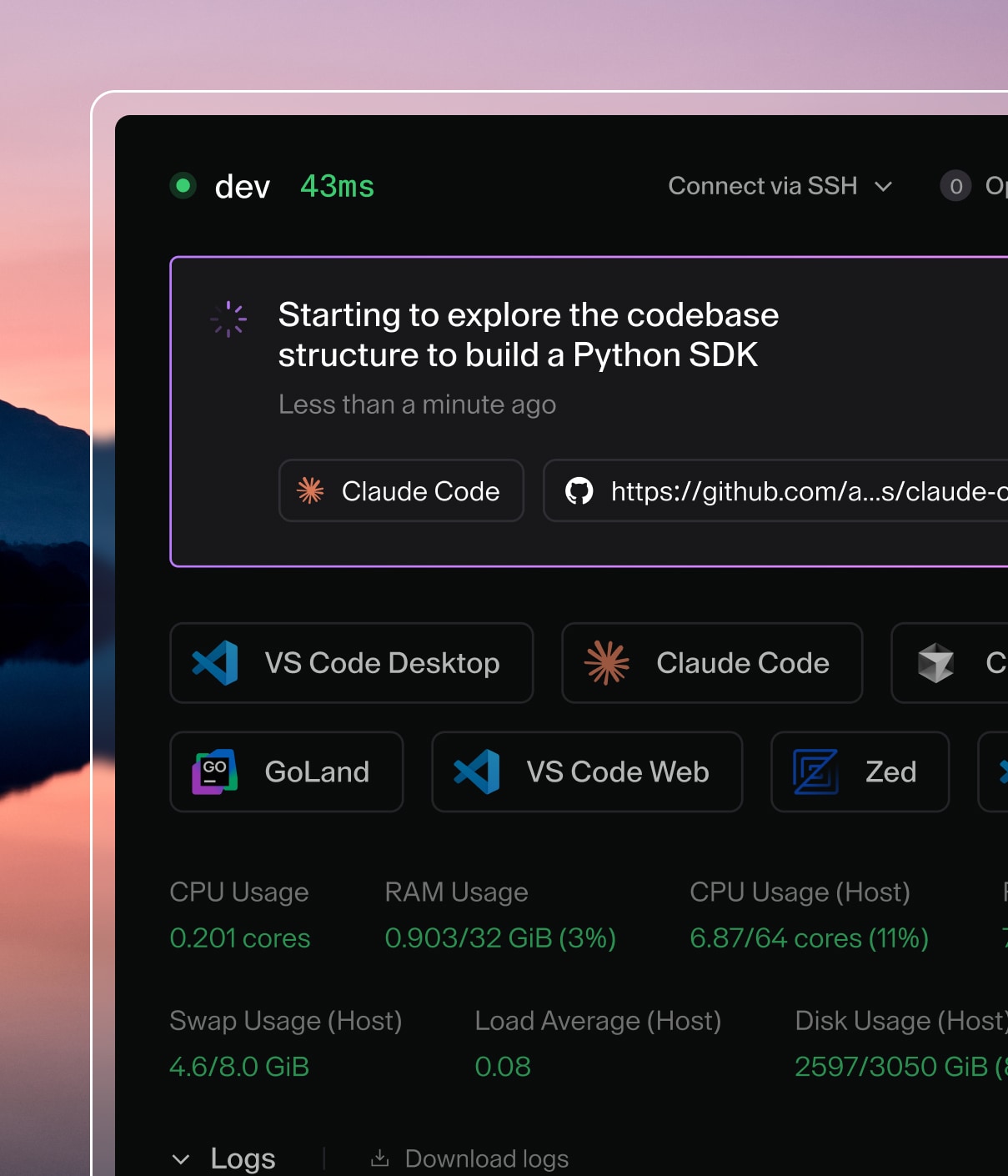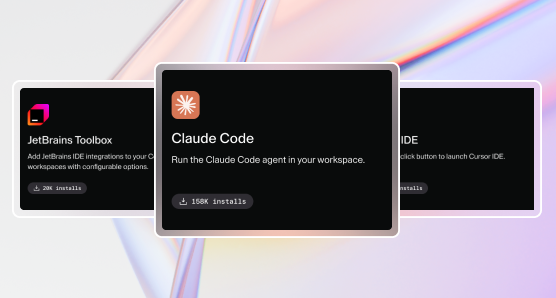The AI-Native Developer Stack: Rethinking Code From Ideation To Production In Minutes
This developer stack isn’t on the horizon—it’s here. No-code prototyping, AI-powered development, and cloud-based infrastructure move teams from idea to production in minutes.

Software development can't be bogged down by outdated tools and inefficient workflows. Developers and technology leaders alike expect speed, flexibility, and seamless collaboration.
Three major trends are driving this transformation:
- The lasting impact of remote and hybrid work on developer productivity
- The widespread adoption of multi-cloud environments
- The rise of generative AI in software development
These shifts reshape how software moves from an idea to a finished product. They demand a development stack that prioritizes speed, security, and flexibility. Businesses adopting this emerging developer stack will build faster, reduce friction, and outpace the competition.
To better understand how you can take advantage, Coder released its State of Development Environments 2025 report. We use the data in the report to dive into why these trends matter, detail what the new developer stack looks like, and summarize how it will benefit you.
Why we need a new approach for developers
Remote and hybrid work exposed inefficiencies
Traditional development workflows weren’t built for a distributed workforce. Outdated VPNs, disjointed tools, and sluggish communication slowed development. As burnout and turnover increased, companies had to rethink how they support their developers.
Developers need instant access to their environments without battling VPNs or waiting on slow provisioning. Yet, long setup times remain a challenge—only 7% of organizations can create environments in under an hour, while 21% take more than two days. Despite this, only 14% of organizations prioritize reducing these setup times, creating a critical inefficiency in development.
Teams need visibility into workflow bottlenecks without intrusive monitoring. And businesses must ensure security and compliance without adding more complexity. The old way of working simply doesn't scale.
Multi-cloud is the new reality
Enterprises no longer rely on a single cloud provider. They mix and match services to control costs, improve reliability, and take advantage of best-in-class tools. But this flexibility comes at a cost—development across multiple clouds introduces complexity. While multi-cloud offers flexibility, it also introduces inefficiencies that slow development.
Each platform has different configurations, security policies, and integrations, making it harder for developers to work efficiently. Developers spend too much time adapting to different environments. Security teams struggle to maintain visibility across platforms. And companies risk losing the speed and agility that multi-cloud was meant to provide in the first place.
Generative AI is redefining development
AI isn’t just an enhancement—it’s transforming how software is built. Developers now rely on AI-powered tools to write, debug, and optimize code faster than ever. Even non-developers can contribute through natural language interfaces, lowering the barrier to entry and increasing collaboration. These no-code app builders allow anyone to prototype ideas quickly, making it easier to test concepts before committing to full-scale development.
But this shift brings new challenges. Teams must adapt to AI-assisted workflows, ensuring code quality and security without slowing down innovation. The traditional development process wasn’t built for this level of automation. To fully unlock AI’s potential, a new developer stack is required—one that integrates AI seamlessly while maintaining control and reliability.
How the AI-native developer stack works
A new pattern is emerging—one that removes friction from development, simplifies cloud complexity, and enhances security without slowing teams down. The new developer stack consists of two core components that embrace AI natively: developer tools that streamline ideation and development, and cloud tools that provide secure, scalable infrastructure.

Developer tools: From ideation to development
Developers need a faster way to move from idea to production. The AI-native developer stack introduces three critical coding tools:
- No-code app builders – Platforms like bolt.new let developers – and soon, anyone – mock up ideas before committing to full development. Instead of starting in an IDE, anyone can quickly prototype, test early concepts, and validate ideas.
- AI-powered IDEs – Developers can transition from prototyping in a no-code environment to an AI-enhanced IDE. Tools like Cursor assist with coding, debugging, and refactoring, making full-scale development more efficient.
- Secure browsers – Platforms like Island provide built-in security like data leak prevention and device integrity checks while allowing access to development tools like Jira and Slack.
This combination allows for rapid iteration and ensures that developers only invest in writing production code after testing their ideas.
Cloud tools: Maintaining a consistent, secure environment
We found 73% of developers need approval to deploy a new tool. Another 14% cannot choose at all. In the AI-native developer stack, surrounding infrastructure tools make coding faster, more secure, and more efficient by enabling tool choice.
- Cloud Development Environments (CDEs) – Solutions like Coder reduce local setup time by offering on-demand, pre-configured environments to handle cloud infrastructure, libraries, and plugins.
- Internal Developer Portals (IDPs) – The ever-popular Backstage project act as a central hub, enabling self-service for developers to connect to repositories, services, and tools in one place.
- Developer Experience (DevEx) Monitoring – Tools like DX provide real-time insights independent of the developer stack to measure productivity regardless of local, cloud, or hybrid environments.
Integrating these tools focuses developers on writing code instead of managing configurations, environments, and access. Visibility across the entire development workflow helps identify bottlenecks, improve efficiency, and ensure a seamless developer experience.

The benefits of the AI-native developer stack
We found that 35% of respondents cited virtual desktop infrastructure (VDI) as still being the organization standard for developers. But ask any developer and they will shake their fist in the air, cursing their VDI. Adopting this modern developer stack isn’t just about efficiency—it gives developers the tools they need to build better software, faster.
Companies that make the shift gain key advantages:
- Seamless developer experience – No setup delays, no access headaches, and just instant prototyping and coding.
- Stronger security and compliance – Secure browsers and centralized CDEs reduce exposure to security risks.
- Faster software delivery – Less friction means more time spent building and shipping versus battling tools.
- Lower operational costs – Eliminating VPNs, VDIs, and manual provisioning reduces infrastructure overhead.
- Future-proof flexibility – As AI, multi-cloud, and development tools evolve, this stack adapts without disruption.
With 78% of organizations planning to standardize their development environments in the next year, the shift is already underway. However, confusion persists—while 79% of respondents report using fully managed cloud-hosted environments (CDEs), half have a limited understanding of their technical features. It's time to close the gap. It's time to rearchitect the stack.
Deploy the AI-native developer stack today
This developer stack isn’t on the horizon—it’s here. No-code prototyping, AI-powered development, and cloud-based infrastructure move teams from idea to production in minutes. They build AI into the developer workflow, as well as use it internally to automate operations.
At Coder, we’ve integrated with Cursor, Island, Backstage, and DX to help teams deploy this architecture today. Get started today—visit github.com/coder or contact us to implement the AI-native stack in your organization.
Subscribe to our newsletter
Want to stay up to date on all things Coder? Subscribe to our monthly newsletter and be the first to know when we release new things!


